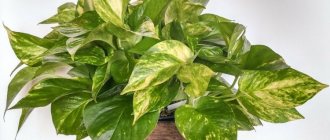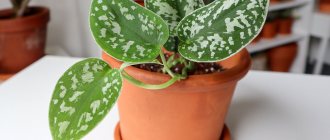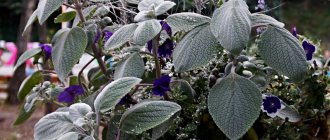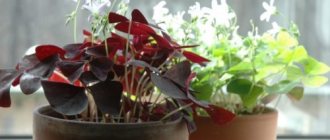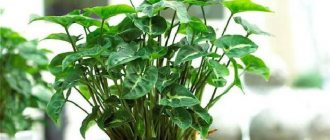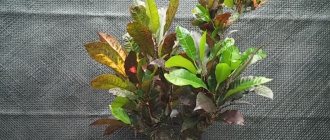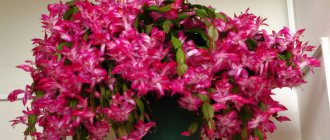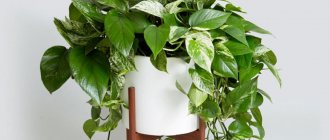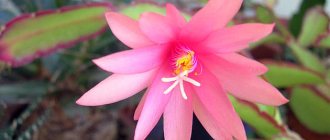floravdome.ru > Araceae > Top 20 Scindapsus species photo varieties + rare
Epipremnum pinnatum (pinnatum) in nature (Photo - macroid.ru)
Scindapsus (Scindapsus) - evergreen climbing vines from the tropics of Southeast Asia, Indonesia, Polynesia and even the north of Australia. Scindapsus belongs to the large and diverse Araceae .
In the natural environment, scindapsus are powerful plants; their thick stems wrap around huge tropical trees, growing up to 40 meters or more. Aerial roots help them cling to tree bark and obtain nutrients from it. The leaves of adult plants can grow up to half a meter! But this only happens in the native tropics. At home, the size of scindapsus is much more modest, but with good care you can easily grow a five-meter vine.
Scindapsus and epipremnum differences
In recent years, many species that were classified as Scindapsus are now classified as Epipremnum . The differences between these two species are insignificant and work on classification is still underway, but for now for gardeners these names are synonyms and are used interchangeably.
The main difference, visible to a non-specialist, is the presence of aerial roots and their rudiments . In scindapsus, aerial roots are located only in the nodes, and in epipremnums - along the entire length of the stem.
It is also worth noting that work on the study of plants continues, and the classification is constantly updated and refined.
The difference between scindapsus and epipremnum is its aerial roots (Photo - Olga Nikonorova/vk.com/terra_doma)
In nature, there are about 25 varieties of scindapsus. Their differences from each other are in the shape and color of the leaves. In terms of growing conditions, they are practically no different.
For indoor and home cultivation, 6 species and varieties or hybrids are used, bred by breeders on their basis.
I would like to note that some varieties have very little difference between each other, and if you want to purchase a plant of a certain specific variety, it is better to do this in specialized nurseries or from collectors who can accurately classify the plant.
Let's look at the main types and varieties of scindapsus:
Scindapsus pictus or Scindapsus pictus
A very popular and widespread species.
The adult leaf is matte dark green with a thin white edge. Silvery-white spots of various sizes are scattered across the entire surface of the leaf. A characteristic feature of the species is the asymmetry of the leaves relative to the central vein.
Under good conditions and high humidity, scindapsus leaves can grow up to 15 cm.
Scindapsus pictus
Varieties of scindapsus pictus (painted) :
Scindapsus Argyraeus
A popular variety of scindapsus painted. Wide small leaves with small white spots.
Scindapsus pictus Argyraeus
Scindapsus Pictus Trebie
A common variety - large asymmetrical leaves with a light contrasting pattern - spots, strokes, stripes. The leaf is slightly embossed, the surface of the leaf is velvety. Unpretentious, shade-tolerant, but the brightness of the pattern depends on the intensity and duration of lighting.
Scindapsus pictus Treble
Scindapsus Pictus Silvery Ann or Satin Pothos
Silvery spots almost completely cover the matte green surface of the leaf. Of all the varieties of Scindapsus painted, Silver Ann has the most extensive coverage of spots of the main green background. Sometimes the surface of the sheet appears completely silver.
Scindapsus Pictus Silvery Ann
Golden scindapsus (Scindapsus aureus) or Epipremnum aureus (Epipremnum aureus)
The most common type of scindapsus in indoor floriculture.
An unpretentious liana with bright leaves grows rapidly, fits into any interior, does not require much attention, with the exception of regular watering and periodic pruning. The more light the plant receives, the brighter the pattern on the leaves and the more intense the color. In shade and partial shade, golden scindapsus acquires a uniform dark green color.
In the USA, Scindapsus aureus is called "golden pothos" (pothos is another plant from the araceae family with confusion in classification).
Golden scindapsus (Scindapsus aureus)
Varieties of golden scindapsus:
Scindapsus Golden Queen Golden Queen
The leaf is a bright, rich green color, on which there are golden-yellow strokes, spots and stripes, often merging with each other. Similar colors appear in daily sunlight. With a lack of light, the leaf acquires a uniform green color.
Scindapsus aureus Golden Queen
Scindapsus Marble Queen
Coloring – white strokes and stripes densely, almost completely cover the dark green color of the base. In good lighting, white becomes the predominant color in the color; some leaves can grow completely white.
Scindapsus Marble Queen
Scindapsus N'Joy
A young Dutch variety that quickly gained popularity. The leaf is small, compared to other varieties, more rounded. Color – dark green base covered with white streaks. The leaves are contrasting and look very bright and elegant. If you plant several cuttings in a pot, the flower will grow into a dense, dense compact bush. It is recommended to grow as a hanging plant.
It grows well in partial shade, but the more light, the brighter the pattern and the larger the leaf.
Scindapsus N'Joy
Scindapsus Neon or Epipremnum Golden Neon or Golden Pothos
Large, up to 10 cm leaves on long petioles. The color of the leaves is a bright luminous light green. At home it can grow up to 5 meters, so it requires support or constant pruning.
Scindapsus Neon
Scindapsus Exotica
Heart-shaped leaf with a relief surface. The color is matte green with silver streaks from the central vein to the edges.
Scindapsus Exotica
Scindapsus = Epipremnum Moonlight
Similar to Exotica , but the leaves are narrower, dark green, single-colored with a distinct silvery tint.
Scindapsus Epipremnum Moonlight
Scindapsus = Epipremnum Jessina
Marble coloring - the leaf is densely covered with strokes and stripes of yellow color. Outwardly similar to Marble Queen , but Marble Queen has a lighter color, and Jessina has golden-yellow-green shades.
Scindapsus = Epipremnum Jessina
Scindapsus Marble Apple Marble Apple
The rounded leaves are dark green in color with watercolor “bays” of light green, white, and cream. Light areas may include green flecks.
Scindapsus Marble Apple Marble Apple
Scindapsus Manjula or Happy Leaf (Scindapsus= Epipremnum Manjula, Happy Leaf)
The leaves are large, heart-shaped, multi-variegated - a mixture of green, pale light green, cream and white flowers interspersed with green, often with a silvery tint. Similar to Marble Apple , but the leaf is more rounded and the edge of the leaf is wavy.
Scindapsus Epipremnum Manjula, Happy Leaf
Scindapsus Jade (Scindapsus= Epipremnum Jade) Jade
Heart-shaped shiny leaves of dark green color.
Scindapsus Jade (Scindapsus=Epipremnum Jade) Jade
Scindapsus Pearl & Jade Pearl and Jade
White-green variegation from the middle of the leaf to the edges. Light areas may contain inclusions. The leaf is smaller and does not grow quickly.
Scindapsus Pearl & Jade Pearl and Jade
Top dressing
Scindapsus does not need regular feeding and does not require much fertilizer. During the active growing season or when in cool rooms, you can feed with a weak solution of complex organic or mineral fertilizers. The interval between feedings is 30-40 days.
Read more about planting hyacinths in the fall.
Find out more about propagating ficus from cuttings with a photo report.
Scindapsus perakensis
A rare species with shiny long arrow-shaped leaves of rich green color. Unpretentious and shade-tolerant.
Scindapsus Perakensis
Interesting varieties of the species Scindapsus Pinnatum = Epipremnum Pinnatum
The leaves of plants of this species, as they grow older, split naturally in the same way as those of scindapsus relatives in the aroid family - monstera, syngonium, philodendron.
Due to the external similarity of adult leaves, sometimes confusion occurs with the definition of not even the variety, but the type of plant!
Scindapsus pinnatum varieties:
Scindapsus Mosstok = Epipremnum Mosstok
A rare species of scindapsus with large leaves with yellow streaks on a light green background. Mature leaves are dissected into segments.
Scindapsus Epipremnum Mosstok
Scindapsus pinnatum Skeleton key (Scindapsus pinnatum = Epipremnum pinnatum Skeleton key)
An interesting and unusual Thai variety. Small leaves of rich green color change to an unusual shape as they mature, “growing” a long arrow-shaped process at the end.
Scindapsus pinnatum Skeleton key (Photo - Etsy.com)
Scindapsus Cebu Blu = Epipremnum pinnatum Cebu Blue
Narrow elongated leaves are bluish-green in color with a metallic sheen. With bright light and good care, mature leaves naturally split into random segments.
Scindapsus Cebu Blu = Epipremnum pinnatum Cebu Blue
Scindapsus = Epipremnum pinnatum Albo Variegata
A rare variety with large, up to 40 cm, heart-shaped leaves that split as they mature. The variegation is clear - white strokes, stripes, spots, segments on a bright green background. English name: White Variegata
Scindapsus pinnatum Albo Variegata (Scindapsus = Epipremnum pinnatum Albo Variegata)
Scindapsus of different types and varieties are equally unpretentious and grow well with minimal care. But in order to get a beautiful and healthy plant, and also not to have unnecessary troubles in the future, you need to immediately provide the minimum suitable conditions for the flower.
You can read the full article on caring for scindapsus here .
Firstly, the location . Scindapsus grow well in the shade, but most ornamental variegated varieties show the beauty of their leaves in bright, long-lasting light. In the shade, their colors fade and the leaves become uniformly green. This is especially true for variegated (variegated) varieties of golden scindapsus - golden queen, marble queen and others. Painted scindapsus is more resistant to partial shade. The plant should be shaded from direct sunlight; only morning light is permissible.
Another important factor when placing the plant is the absence of drafts, sudden temperature changes and cold air currents. In winter, just one draft can be detrimental to a plant.
Scindapsus are heat-loving and grow well at an average temperature of +20° - 23°. In winter, it is permissible to lower the temperature to an average of +18o, but not lower than +15o. +12o is the critical threshold. In summer, scindapsus tolerate short-term increases up to +30o well, but in such weather they require additional spraying and more frequent watering.
Scindapsus (Epiprumnum) popular varieties: Golden Queen, Marble Queen, N-Joy, Neon
Secondly - watering . As natives of the humid tropics, scindapsus require regular watering. The signal for watering is the drying of the top layer of soil by 2-3 cm. In summer, watering is required frequently, in winter - less often. It is not recommended to allow the earthen coma to dry out completely. Also destructive is the “flooding” of the plant, stagnation of moisture in the pot, and acidification of the soil. This will inevitably lead to rotting of the roots. For irrigation, use only water that has been standing for at least a day. It is better if the water is 2-5 degrees warmer than room temperature.
As additional moisture, you can regularly spray the plants , although they tolerate average indoor air humidity normally. But in dry air and winter, spraying is required. In summer, a warm shower is recommended as additional care. If the plant is located near a window, then after a shower it is recommended to dry it completely before putting it back.
Scindapsus pinnatum = Epipremnum pinnatum Varieties: Cebu Blue and Alba Variegata
Possible problems
If the rules of care are violated, the plant develops painful signs.
- Dark spots on the leaves indicate waterlogging of the soil. The frequency of watering and the volume of water should be reduced.
- Pale color of leaf blades - exposure to direct sunlight, too intense lighting. You need to move the flower to a darker place, shade it.
- Scindapsus stops growing , the leaf blades become sluggish and lose their shine - insufficient watering, too much dry air.
- Leaves fall sharply and unexpectedly - a sign of rotting of the root system. Replant the plant in new soil using a smaller pot and water less often.
Transplantation of scindapsus
Transplantation of scindapsus is done once a year for young plants. The pot must have large drainage holes, and a drainage layer must be placed on the bottom. soil . The main thing is that it allows moisture to pass through well.
Usually several cuttings are planted in one pot. Scindapsus can be grown as hanging plants, but to make caring for them easier, it is better to place a support in the center of the pot, or next to the plant. This will allow the plant to grow upwards unhindered and eliminate the need for constant trimming of excessively long hanging vines.
Feeding 2 times a month with complex fertilizer for decorative deciduous plants will have a positive effect on the growth and appearance of the plant.
Humidity
Scindapsus can adapt to dry air, but grows better in conditions of high humidity.
The optimal humidity level for scindapsus is about 60% . If this condition is maintained, the leaves will be bright and elastic.
In winter, the plant should be placed away from heating devices, since hot, dry air has a negative effect on the health of the flower. You can place the pot in a tray filled with damp moss, pebbles or expanded clay.
Scindapsus reproduction
Scindapsus is propagated by cuttings . This is the only possible way at home. Cuttings are rooted in water or nutritious peat substrate. You can cut the cuttings into pieces with a pair of leaves each, or, without cutting, fix the stem in the ground. After some time, roots will grow at the site of contact with the ground, and the young plant can be separated from the mother plant.
Golden scindapsus in the interior
With proper care and compliance with all growing conditions, scindapsus is resistant to diseases and pests.
Conclusion
In conclusion, I would like to say that scindapsus is among the top useful plants . It purifies the air from almost all harmful chemical compounds released by modern finishing materials, and successfully fights germs and bacteria.
Scindapsus is great for both experienced gardeners and beginners. The useful qualities of the flower, bright appearance suitable for any interior and ease of care make it an almost ideal plant for indoor growing.
Rate this article if it was useful to you.
Share the article with your friends.
Share link:
Rate the article!
[Total: 15 Average: 4.9]
How to assess the situation
What to consider when choosing a houseplant:
- Room size and design
- Level of natural light
- Temperature in the room
- Ability to provide sufficient humidity levels
- Benefit or danger to humans and animals
- View photos of scindapsus and choose the flower you like
